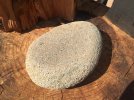The 'Sharpening LIfe' gets much, much easier once you realize that certain kinds of steels really like certain kinds of stones, and vice-versa. Even the cheapest diamond hone will cut a high-wear steel much, much more easily than will an expensive, quality natural stone that has to struggle with carbides in the steel that could be 3X as hard as than the hardest grit in the natural stone. And as those carbides effectively polish or 'glaze' the grit in the natural stone, its ability to cut anything at all, steel-wise, will slow exponentially. The stone will struggle to get anything done on any steel, unless or until it gets resurfaced again. Odds are, most hobbyist sharpeners will get very tired of doing that over and over just to make that favorite old stone continue to 'work' (sort of) with much more modern steels.
Natural stones are a beautiful thing when matched up to the steels they were originally intended to sharpen. Stuff like basic carbon steels (1095, CV, etc.) and low-alloy stainless like 420HC can respond nicely to natural stones and won't be significantly damaged (glazed) in doing so with such steels. And for somewhat more wear-resistant stainless steels like 440C, etc., a decent synthetic stone in aluminum oxide or silicon carbide (SiC) can be a beautiful thing. Then along comes a steel like S30V/35VN or any other with more than maybe 3-4% vanadium content, for which a diamond hone will make sharpening seem stupid simple in contrast to all the struggles that'll come with trying to sharpen it on a natural stone.
On anything very wear-resistant, I've sometimes liked a hard Arkansas stone (black hard, or translucent) functioning solely as an edge aligner like a kitchen steel, or as a burnisher, which basically moves steel around in sort of a plastic manner without actually cutting it, to thin an edge. But that's as much as I expect from a natural stone on such steels. If much has to be ground away from a very dull or damaged edge on a high-wear steel, something other than the natural stone will be called to duty.


